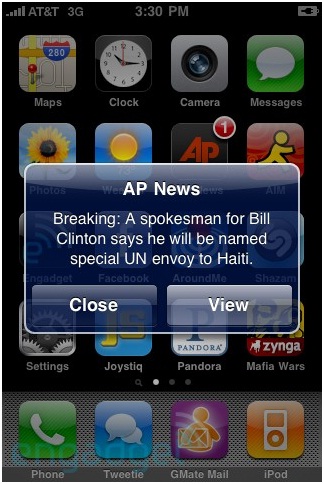How Push Notifications Can Make or Break Your App Experience
Over the past few years I’ve notice that there are a few different types of app push notification strategies on my phone apps. Some of them work, some of them are useless, and some of them help me significantly in my daily routine.
Here are the three types of push notifications strategies. Some smart, some dumb, and some unnecessary. Now, keep in mind, we want to shine some light on how these behaviors and strategies effects change and user action in and outside of apps.
Type 1: Smart Push Notifications
The myMail app has a push notification system that let’s you choose when to see the things you want in push notifications. You can also choose to have those push notifications private so the sender is hidden and the subject from your badge notifications.
Type 2: Aggressive Push Notifications
There are few apps that I use that are just pushing my notifications all the time. It’s really up to the user’s tolerance (which typically has to do with the level of tech proficiency). These never work and users typically will uninstall or turn off the notifications. Either way it’s not retaining any usage of the app.
Type 3: Push Notifications With Bad Timing
Some apps build push notifications in all the wrong places. When these are at the beginning the customer storyboard, for example, they can sometimes lose the customer before he’s converted to a full user. Carelessly placed, these can cause immediate uninstalls with users.
How To Segment Push Into Different Customer Experiences
Depending on the industry, there can be some really smart places to put push notifications in in app experiences. For news sites, segmenting them into breaking, or topic interested custom notifications is an advanced way to innovate.
Studies show that forming habits with push notifications create patterns that people can grow accustom to.
Here’s how you do it:
1. Unite external & internal triggers together
2. Use internal notifications with emotional triggers
3. Incorporate emotions from the app into the notification
4. Interact like a person would if it were a real life experience
5. Intro screens should give advantages of the app
These all need to be tested and measured, but once optimized, you’ll see a larger engagement from your users.
Think of it like using a trip wire on a website.
The only thing that matters is driving actions, and that only happens from emotions.
So, start documenting all of the emotions your user may have during their in app experience.
They may be some emotions like:
â— Lonely users check their messages often.
â— Bored users check Instagram and YouTube.
â— Gamers get bored mid-level in games.
â— Phrasing should be tested for each scenario.
â— Humor & cheekiness works well in notifications.
Lessoned We Can Learn From Smart Notifications
Pressuring the user about the push settings may not be the best thing to do. Users don’t want to tell an app no twice. They want the app to be helpful.
66% of users give permission after app tips are shown on the screen. Only use this if the app is in a new industry or has a lot of new behavioral or tutorial content. Access to contacts or photos should be left for only the times when they are needed in the app.
Privacy is a major added value. If you have the app to support it, make it an option and make it easy to find.
Social sign ins are looked at the same way payments are.
Wait as long as you can to ask the user to sign in. Use this checklist to make sure all of these emotional triggers have been completed before asking the user to sign up.
1. Demo has been passed.
2. Tips have been displayed.
3. Privacy has been covered.
4. Make it on tap if you can.
What we’re learning is to start building everything around experiences in addition to visuals. Here’s the difference…
Visuals open the aesthetic sensors in the brain and allow for ease of use. Think of it like a pretty picture, if it’s pretty enough, staring at it isn’t that large of a task.
Experiences are what triggers memory, loyalty and empathy.
Think of it like a vacation. You remember the ones that you did the craziest adventure on, and you probably remember it fondly.
Actions and reactions are all controlled from an in app cross pollination between push notifications, experiences and familiarity. If you learn a lot from that web, you’re ahead of the game.



 Ann
Ann






